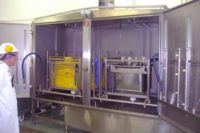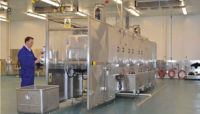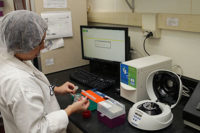The centuries-old process of smoking meat has taken a new turn. Instead of using the customary smokehouse to preserve and enhance the flavor of meats, food processors are integrating the smoking and browning into inline cooking, which not only simplifies a laborious process, but also delivers significant health and competitive advantages.
The use of smoke condensate (aka “liquid smoke”) in combination with automated pasteurization equipment, such as an inline infrared pasteurizing tunnel, provides manufacturers of smoked products with significant process and product benefits, while eliminating many of the unwanted side effects of the traditional smokehouse method.
Wood condensates have been produced for more than 50 years by condensing the vapors in “smoked” water made by cooking charcoal and the chips of sawdust of various species of wood. Condensates have three major components: acids, for smoking; phenols, for flavor; carbonyls, for browning, or achieving a “smoked” color. By manipulating those components as well as the type of wood and cooking process, manufacturers that smoke with condensates are able to deliver the exact taste and appearance specified by the customer.
Simplifying the process
The use of the smoke condensate in combination with the infrared pasteurization has paid great dividends for CIAL Alimentos, a major processor of sausage, turkey and ham products located in Pudahuel, Santiago, Chile.
“Our plant updated its smoking process, previously utilizing smoked wood, to greatly improve on the smoking time and throughput while eliminating the risk of fire and reducing air pollution,” explains Gerardo Zuccarelli Offermanns, assistant process manager.
He adds that the firm, which produces approximately 35 tons of smoked turkey and pork products per day, now smokes those products at a rate of 29 items per minute instead of taking two to five hours using the traditional wood-burning process.
“The system is very flexible,” Gerardo explains. “Using this system, I can now smoke different products at the same time.”
Many processors incorporate a smoke condensate drench system at the in-feed of the infrared pasteurizer, providing an inline smoking process and a quick surface treatment to pre-cooked products to naturally eliminate bacteria and increase shelf life by 30 to 50 percent.
After the product is cooked and chilled, the condensate is applied to the outside of the meat, which then continues through the infrared pasteurizer for about a 60-second dwell time. In addition to achieving the smoking and some surface texturizing, surface heat applied by the pasteurizer causes a Maillard reaction for the browning. So, after about a minute, instead of hours, the product can be retail packaged with no further post-packaging pasteurization required.
By smoking inline, manufacturers eliminate the lengthy smokehouse process, which can increase plant capacity by 30 percent.
The automated smoke condensate method also pays off in terms of yield loss. The typical yield loss using the traditional smoking process is between 9 and 12 percent. Because of low process residence time, inline smoking using condensates results in a yield loss of only about two percent.
For information contact: Unitherm Food Systems, 502 Industrial Road, Bristow, OK 74010; Phone: 918-367-0197; Fax: 918-367-5440; e-mail: unitherm@unithermfoodsystems.com; Web site: www.unithermfoodsystems.com.







Report Abusive Comment